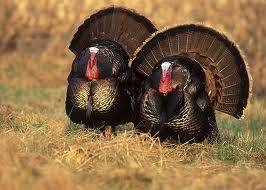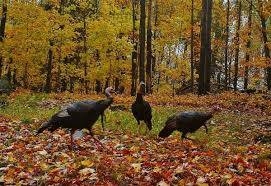
1 Photos
roanoke.com
The mountains of Southwest Virginia, from the Roanoke Valley westward, will be a prime spot for turkey hunting when the season opens Saturday.
According to the Department of Game and Inland Fisheries’ 2014 brood survey, which was released Monday, turkeys observed by wildlife officials in this region were twice the number of the statewide average. The count of young birds per hen also was the best in the state.
"Overall, recruitment was exceptional in the South Mountain Regions, the best among the regions of the state,” reported Gary Norman and Katie Martin, the DGIF biologists who compiled the report.
In contrast, the North Mountain Region, which once held the highest turkey population in the state, had the lowest count in the 2014 survey. That region is from Alleghany, Bath and Rockbridge counties northeastward up the Shenandoah Valley.
“Over the past 20 years the turkey population in the region has declined steadily and now many counties in the region have some of the lowest population indices in the state,” Norman and Martin reported.
This doesn’t speak well for population growth. Habitat loss may be impacting the population, the biologists said.
The brood count took place in August when DGIF staffers were directed to record the number of turkeys observed per 1,000 miles of driving. That figure was approximately 30, which was the second highest reported since the survey was initiated in 2007. The average is approximately 20 birds.
The number of young birds per hen, an indication of reproductive success and survival, was 2.4, which was below the long-term average of 2.7, but similar to the numbers reported in 2012 and 2013. The highest count was 3.3 juveniles per hen reported in 2011.
The number of turkeys observed suggests that the population is near record levels for modern times, the report concluded.
Good numbers of turkeys won’t necessarily mean a big kill by hunters. A heavy mast crop is expected to scatter the birds and make them more challenging for hunters to locate.
On Saturday’s youth and apprentice day, participants reported by phone or email that they killed 37 turkeys (others were checked at big game stations and will be counted later). The kill the previous year was 41.
“Ordinarily you might be disappointed with these numbers, but I’m not surprised as I expect the kill to be down due to the generally abundant mast crop,” said Norman.
FALL SEASON:
October 25 through November 7, November 27, December 1 through 27, and January 10 through 24.
BAG LIMIT:
One per day, three per license year, no more than two of which may be taken in the fall.
Star City Whitetails thanks Bill Cochran for allowing us to share this valauable information
roanoke.com
The mountains of Southwest Virginia, from the Roanoke Valley westward, will be a prime spot for turkey hunting when the season opens Saturday.
According to the Department of Game and Inland Fisheries’ 2014 brood survey, which was released Monday, turkeys observed by wildlife officials in this region were twice the number of the statewide average. The count of young birds per hen also was the best in the state.
"Overall, recruitment was exceptional in the South Mountain Regions, the best among the regions of the state,” reported Gary Norman and Katie Martin, the DGIF biologists who compiled the report.
In contrast, the North Mountain Region, which once held the highest turkey population in the state, had the lowest count in the 2014 survey. That region is from Alleghany, Bath and Rockbridge counties northeastward up the Shenandoah Valley.
“Over the past 20 years the turkey population in the region has declined steadily and now many counties in the region have some of the lowest population indices in the state,” Norman and Martin reported.
This doesn’t speak well for population growth. Habitat loss may be impacting the population, the biologists said.
The brood count took place in August when DGIF staffers were directed to record the number of turkeys observed per 1,000 miles of driving. That figure was approximately 30, which was the second highest reported since the survey was initiated in 2007. The average is approximately 20 birds.
The number of young birds per hen, an indication of reproductive success and survival, was 2.4, which was below the long-term average of 2.7, but similar to the numbers reported in 2012 and 2013. The highest count was 3.3 juveniles per hen reported in 2011.
The number of turkeys observed suggests that the population is near record levels for modern times, the report concluded.
Good numbers of turkeys won’t necessarily mean a big kill by hunters. A heavy mast crop is expected to scatter the birds and make them more challenging for hunters to locate.
On Saturday’s youth and apprentice day, participants reported by phone or email that they killed 37 turkeys (others were checked at big game stations and will be counted later). The kill the previous year was 41.
“Ordinarily you might be disappointed with these numbers, but I’m not surprised as I expect the kill to be down due to the generally abundant mast crop,” said Norman.
FALL SEASON:
October 25 through November 7, November 27, December 1 through 27, and January 10 through 24.
BAG LIMIT:
One per day, three per license year, no more than two of which may be taken in the fall.
Star City Whitetails thanks Bill Cochran for allowing us to share this valauable information

